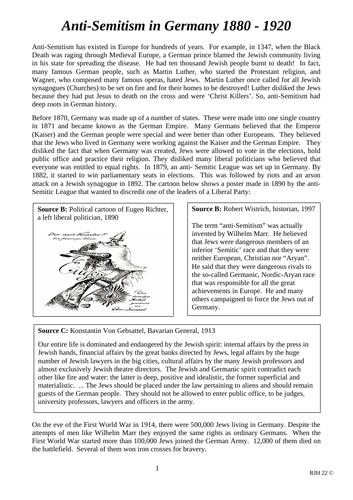





This worksheet was originally written for a series of AQA KS4 coursework lessons on how the ‘status’’ and ‘position’ of Jews changed in Europe 1880 - 1920. I have updated the resource and redesigned this lesson so it serves as an introduction to anti-Semitism in Weimar Germany.
The content of the lesson outlines the origins of anti-Semitism in Medieval and Reformation Germany and then focuses on its revival in 1880 and how it evolved as a result of the impact of the First World War and the crisis that Germany was facing in the early years of the Weimar Republic. The questions, graphic organiser and card sorts are all aimed to get students to analyse the sources and evaluate how the events impacted the ‘status’ and 'position of German Jews.
When you purchase this resource you will be able to download both a Word and PDF version of the worksheet and the supporting graphic organiser and card sort. This particular version is our budget version, for a bit more you can buy the fun and interactive PowerPoint that accompanies the lesson. This resource is suitable for KS4, but is frequently used by Sixth Form students studying the topic at A Level so we uploaded this version to make it more affordable. You can also download from the TES our free resources on anti-Semitism in France and Russia covering the same period and our ever popular 'Anti-Semitism in Germany 1919 - 1945 booklet.
If you wish to know more, then please see the preview files. The aims and objectives of this lesson are:
Theme: Anti-Semitism
Know: What were the origins of anti-Semitism in Germany?
Understand: How the impact of key events affected the ‘position’ and ‘status’ of German Jews
Evaluate: What was the ‘status’ and ‘position’ of German Jews in 1920?
Skills: Source Analysis, Cause, Consequence & Collaboration
WILF – What Am I Looking For?
Can You Describe: What were the origins of anti-Semitism in Germany?
Can You Explain: The impact of key events on the ‘position’ and ‘status’ of German Jews?
Can You Evaluate: The ‘status’ and ‘position’ of German Jews in 1920?
If you like this resource then why not check out our TES shop, where you can find similar resources that have been bundled to provide you with further savings. You can also follow ‘The History Academy�� on Facebook and You Tube for the latest updates or even to get in touch and chat about how you have used this resource or to ask questions. We aim to produce resources for the price of a good cup of coffee so that you can spend more time doing the things that matter. However, we do not compromise our values and pay all our contributors the living wage for their work.
Kind Regards
Roy
Something went wrong, please try again later.
This resource hasn't been reviewed yet
To ensure quality for our reviews, only customers who have purchased this resource can review it
Report this resourceto let us know if it violates our terms and conditions.
Our customer service team will review your report and will be in touch.
